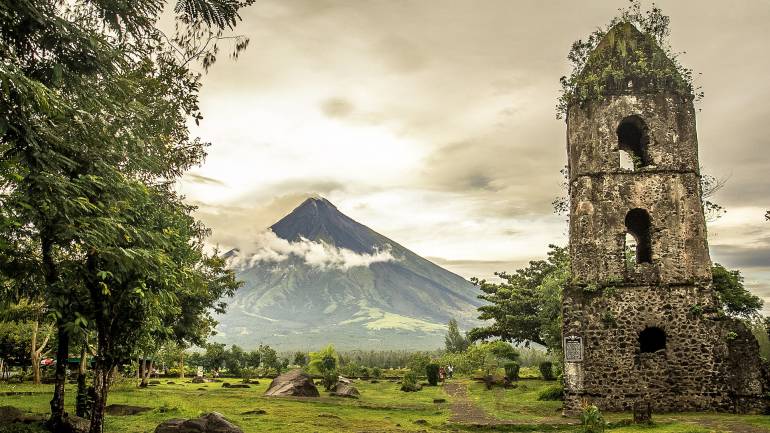Centuries-old surviving church tower in Philippines draws pilgrims, tourists

“Despite eruptions destroying and burying the main structure of the church in the sand, the ruins, which include the tower and part of the convent, should still be considered a spiritual place."
The tower of a church that got destroyed and buried by volcanic eruptions is frequented by visitors in Albay, a province more than 400 kilometers southeast of Manila.
Pilgrims and tourists alike come to whisper some prayer and marvel at the magestic Mayon Volcano, which is renowned worldwide for its perfect cone.
Father Joseph Salando, rector and pastor of the Diocesan Shrine and Parish of Our Lady of Salvation in Tiwi, explained that a Mayon Volcano eruption on February 1, 1814, destroyed the Cagsawa church. Since then, the church has remained abandoned.
"Due to lahar and pyroclastic materials from that eruption and the succeeding eruptions, the church was buried in sand," he said, citing a local document as a source.
According to one account, the Franciscan friars first constructed the church in 1587. The Dutch raiders reduced it to rubble in 1636 by setting the structure on fire.
The Dutch were revolting against Spanish rule at that time and allegedly launching attacks on Spanish possessions in the Philippines.
In 1724, the Franciscans rebuilt the church.
The eruption in 1814—the strongest eruption ever recorded by Mayon Volcano—destroyed the baroque church and Cagsawa town. The survivors evacuated to Daraga, a barrio at the time. Today, Daraga is a first-class municipality, covering the Cagsawa Ruins Park.
In the 1950s, the state made public the significance of the ruins.
"In 1954, a historical marker was placed on the bell tower," Salando said. "Since then, it has become an important structure visited by people to appreciate the view of the Mayon Volcano and the historical value of the ruins."
In the later years, the park set up stores that sold pili nut delicacies, local cuisines, handicrafts, and other souvenir items.
Visitors come to have themselves photographed with the tower as the backdrop and the volcano in the background. The park is about 11 kilometers from the volcano.
Some people love to be told in pictures that they are taller than the tower by using distance to create such an illusion.
In Philippine Information Agency news on August 3, 2023, the state media reported an increase in Cagsawa visitors to 300–500 daily in June compared to 150–200 a day in the past months when the volcano was not flaring up with lava at its crater.
Lava outflows from the volcano's crater are spectacles at night, and people come to the Cagsawa ruins to view the volcanic activity despite the escalation alert raised to level 3.
Albay's tourism office regards the rise in the number of visitors as a boost to the province's economy. It also observes the local tourism boom when Mayon is restive.
Despite the escalation alert, flights to Albay remain operational, leading to a rise in tourist arrivals in the province.
In 2014, local tourism officials reported the need for restoration work on the ruins, citing the possibility of collapse due to a strong earthquake due to their age.
Despite eruptions destroying and burying the main structure of the church in the sand, the ruins, which include the tower and part of the convent, should still be considered a spiritual place.
"Let's not forget that the ruins have not lost its state as a sacred place," Salando said. When there is an important occasion, a mass is celebrated here. We still regard it as a church and a place of prayer. May we respect the religious value of the Cagsawa ruins."











